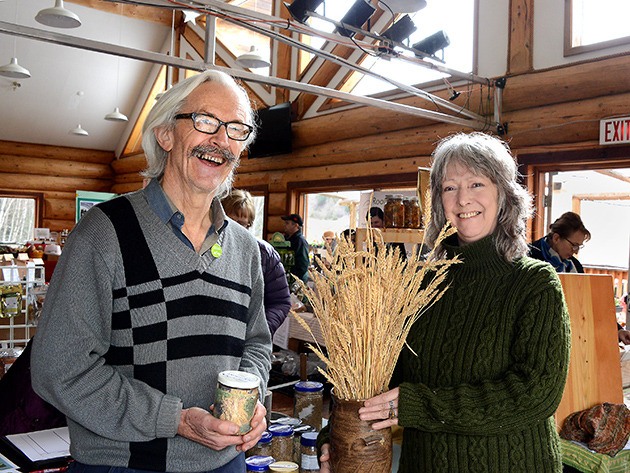Learning About the History of Wheat - The Staff of Life

Keith McNeill
If you want to talk about food security you need to talk about growing your own grain, especially wheat, according to Sharon Neufeld. The Upper Clearwater resident challenges other people in the local area to grow a 10’x10’ plot of wheat this summer.
About one cup of hard red spring wheat seeds would be enough to seed the plot, she said, and it should yield about 90 cups of wheat. Arrangements will be made to collectively process the wheat in the fall.
To further educate people about growing wheat and other food crops, Neufeld helped arrange for Jim Ternier, a co-owner of Prairie Garden Seeds in Saskatchewan, to give a presentation for Seedy Saturday at Clearwater ski hill last weekend.
About 20 people participated in the presentation.
Many people who are intolerant of the gluten in modern wheats can eat einkorn (rhymes with “fine corn”), the most primitive form of wheat, according to Ternier. He was not sure why this would be, as einkorn also contains gluten, but it might be due to the gluten being made up of different proteins.
Einkorn dates back at least 10,000 years, he said. The original wheat was diploid, meaning its cells contained two sets of chromosomes. This is the normal number of chromosomes for most organism. Human beings, for example, have 46 chromosomes (diploid) in their body cells and 23 (haploid) in their sperm and eggs.
Several thousand years ago two species of the original wheat crossed and produced a new type with four sets of chromosomes (tetraploid). These crossed again and produced a hexaploid type, which is what all modern wheats are descended from. It is still possible to buy einkorn (diploid) and emmer (tetraploid) wheat seeds, he said. Their major disadvantage is they are difficult to de-hull.
Ternier also discussed growing tomatoes and other food crops. Most people do not appreciate that there are thousands of varieties of tomatoes. One variety they grow in their hothouse yields fruit of up to one kg each.
One variety he recommended was Gardener’s Delight. Another was Whippersnapper, which he described as an early-producing dwarf that yields tasty fruit. Another plant he mentioned was rat-tailed radish. Unlike most radishes, you eat the pods, not the roots. All parts of the radish plant are edible, Ternier said.
**
Article courtesy of Keith McNeill, Clearwater Times, http://www.clearwatertimes.com/our-town/learning-about-history-of-wheat-the-staff-of-life/
Photo: Jim Ternier(l) of Prairie Garden Seeds holds a small jar of wheat seeds while Seeds of Diversity member Sharon Neufeld holds a sheaf of grown wheat. The seeds were being given out during Seedy Saturday last weekend at Clearwater ski hill. Local residents are being challenged to grow a 10’x10’ plot of wheat using the seeds.
Not yet a member?
An annual membership to Seeds of Diversity gives you access to our seed exchange, seed grow-out programs, and our online news.

We depend on donations to do our work.

Thank you for your support!
